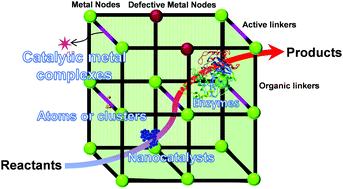Metal–organic framework based catalytic nanoreactors: synthetic challenges and applications
Abstract
Catalytic nanoreactors have become hugely important in the field of heterogeneous catalysis due to their intriguing catalytic activity and the stability of the nanocatalysts inside the protective shell. Metal–organic frameworks (MOFs) are an attractive choice as the shell material for catalyst encapsulation, owing to the remarkable progress that has been made toward developing: flexible synthetic methods, diversified chemical functionalities, tunable pore structures, and low-cost, easy production methods. A porous MOF shell can be combined with in-house catalyst particles to deliver a selectively transformed product, while limiting the loss of activity and surface area of the entrapped catalysts, even under harsh reaction conditions or during recycling tests. Moreover, the rich surface chemistries of MOFs have often guided their direct or indirect participation, influencing the overall outcome of MOF-based catalytic nanoreactors. This review surveys the methods used for functionalizing MOFs with catalyst entities loaded inside. The possible complications during packaging the catalysts of different sizes, shapes, properties, or compositions are considered, and the developed footprints towards overcoming such difficulties have been discussed. Finally, the catalytic applications of MOF-based catalytic nanoreactors in different fields are summarized.

- This article is part of the themed collections: Functional materials for sustainable future - Vision from Korean scientists and 2021 Materials Chemistry Frontiers Review-type Articles


 Please wait while we load your content...
Please wait while we load your content...